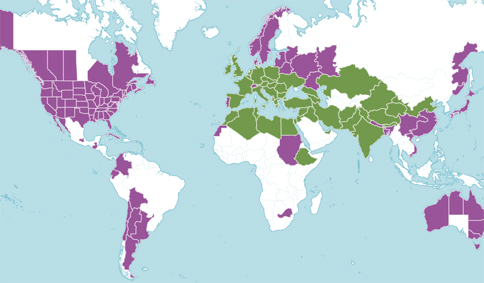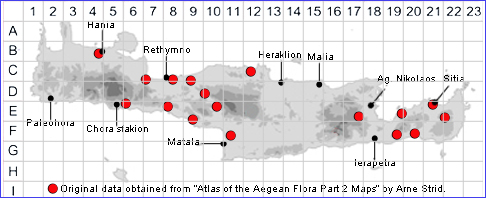Native to:
Afghanistan, Albania, Algeria, Austria, Belgium, Bulgaria, China North-Central, Czechoslovakia, East Aegean Is., East Himalaya, Egypt, Ethiopia, France, Germany, Great Britain, Greece, Gulf States, Hungary, India, Iran, Iraq, Ireland, Italy, Kazakhstan, Kriti, Lebanon-Syria, Libya, Morocco, Netherlands, North Caucasus, Pakistan, Palestine, Poland, Qinghai, Romania, Sardegna, Sicilia, Sinai, Spain, Tibet, Transcaucasus, Tunisia, Turkey, Turkey-in-Europe, Ukraine, West Himalaya, Xinjiang, Yugoslavia
Introduced into:
Alabama, Alaska, Alberta, Argentina Northeast, Argentina Northwest, Argentina South, Arizona, Arkansas, Assam, Azores, Baltic States, Bangladesh, Belarus, Bermuda, Bolivia, British Columbia, California, Canary Is., Cape Verde, Central European Rus, Chile Central, Chile North, China South-Central, China Southeast, Colombia, Colorado, Connecticut, Cuba, Cyprus, Delaware, Denmark, District of Columbia, East European Russia, Ecuador, Florida, Georgia, Guatemala, Hawaii, Idaho, Illinois, Indiana, Iowa, Japan, Juan Fernández Is., Kansas, Kentucky, Khabarovsk, Louisiana, Madeira, Maine, Maryland, Massachusetts, Mexico Central, Mexico Northwest, Michigan, Minnesota, Mississippi, Missouri, Montana, Nebraska, Nepal, Nevada, New Brunswick, New Hampshire, New Jersey, New Mexico, New South Wales, New York, New Zealand North, New Zealand South, Newfoundland, North Carolina, North Dakota, Northern Provinces, Northern Territory, Northwest European R, Norway, Nova Scotia, Ohio, Oklahoma, Ontario, Oregon, Pennsylvania, Portugal, Primorye, Prince Edward I., Puerto Rico, Queensland, Québec, Saskatchewan, South Carolina, South Dakota, South European Russi, Sudan, Sweden, Switzerland, Tasmania, Tennessee, Texas, Utah, Vermont, Victoria, Vietnam, Virginia, Washington, West Virginia, Western Australia, Western Sahara, Wisconsin, Wyoming
Afghanistan, Albania, Algeria, Austria, Belgium, Bulgaria, China North-Central, Czechoslovakia, East Aegean Is., East Himalaya, Egypt, Ethiopia, France, Germany, Great Britain, Greece, Gulf States, Hungary, India, Iran, Iraq, Ireland, Italy, Kazakhstan, Kriti, Lebanon-Syria, Libya, Morocco, Netherlands, North Caucasus, Pakistan, Palestine, Poland, Qinghai, Romania, Sardegna, Sicilia, Sinai, Spain, Tibet, Transcaucasus, Tunisia, Turkey, Turkey-in-Europe, Ukraine, West Himalaya, Xinjiang, Yugoslavia
Introduced into:
Alabama, Alaska, Alberta, Argentina Northeast, Argentina Northwest, Argentina South, Arizona, Arkansas, Assam, Azores, Baltic States, Bangladesh, Belarus, Bermuda, Bolivia, British Columbia, California, Canary Is., Cape Verde, Central European Rus, Chile Central, Chile North, China South-Central, China Southeast, Colombia, Colorado, Connecticut, Cuba, Cyprus, Delaware, Denmark, District of Columbia, East European Russia, Ecuador, Florida, Georgia, Guatemala, Hawaii, Idaho, Illinois, Indiana, Iowa, Japan, Juan Fernández Is., Kansas, Kentucky, Khabarovsk, Louisiana, Madeira, Maine, Maryland, Massachusetts, Mexico Central, Mexico Northwest, Michigan, Minnesota, Mississippi, Missouri, Montana, Nebraska, Nepal, Nevada, New Brunswick, New Hampshire, New Jersey, New Mexico, New South Wales, New York, New Zealand North, New Zealand South, Newfoundland, North Carolina, North Dakota, Northern Provinces, Northern Territory, Northwest European R, Norway, Nova Scotia, Ohio, Oklahoma, Ontario, Oregon, Pennsylvania, Portugal, Primorye, Prince Edward I., Puerto Rico, Queensland, Québec, Saskatchewan, South Carolina, South Dakota, South European Russi, Sudan, Sweden, Switzerland, Tasmania, Tennessee, Texas, Utah, Vermont, Victoria, Vietnam, Virginia, Washington, West Virginia, Western Australia, Western Sahara, Wisconsin, Wyoming

SPECIES DESCRIPTION
BRASSICA NIGRA
Family and Genus:- See- CRUCIFERAE
Common Name:- Black mustard
Homotypic Synonyms:- Crucifera sinapis, Melanosinapis communis,
Melanosinapis nigra, Mutarda nigra, Rhamphospermum nigrum, Sinapis
nigra, Sisymbrium nigrum.
Meaning:- Brassica (L) A name used by the Roman naturalist and philosopher
Pliny for various cabbage-like plants.
Nigra (L) Black.
General description:- Annual.
Stems:-
1) Up to 200 cm, branched from the middle or from near the base.
Leaves:-
1) Lower, lyrate-pinnatisect, with 1-3 pairs of lateral lobes and a much larger
terminal lobe, hispid on both surfaces.
2) Upper, linear-oblong, entire or sinuate, glabrous.
3) All leaves petiolate.
Flowers:-
1) Petals, 7-13 mm, yellow.
2) Pedicels, 2·5-6 mm in fruit, appressed to the stem.
Fruit:-
1) Siliqua, 8-30 x 1·5-4·5 mm, attenuate into a slender, seedless beak.
Key features:-
1) Upper cauline leaves, sessile or petiolate, not amplexicaul at the base.
2) Siliqua, appressed to stem.
Habitat:- Roadsides, wasteground and other anthropogenic habitats. 0-700 m.
Distribution:- Most of Europe but commonest in the centre and south; perhaps
native in parts of S. & W. Europe. Fairly limited distribution on Crete, mainly
central-west and east.
.
Flowering time:- Late Mar to early June.
Photos by:- Courtesy of Wiki-Commons


GLOBAL DISTRIBUTION
Introduced


Native